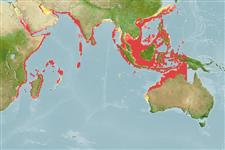Common names from other countries
Environment: milieu / climate zone / depth range / distribution range
Ecología
Asociado a arrecife; rango de profundidad 0 - 183 m (Ref. 101939). Tropical; 30°N - 29°S, 32°E - 137°E (Ref. 847)
Indo-West Pacific.
Length at first maturity / Tamaño / Peso / Age
Maturity: Lm ? range ? - ? cm Max length : 30.0 cm COLD macho / no sexado; (Ref. 269)
A fragile, weedy species often found in dense thickets in a depth of about 6 to 20 m. Individual colonies (up to 30 cm diameter) are formed of thin branches (0.2 to 0.5 cm diameter) which frequently bifurcate and anastomose. Corallites are tiny, superficial, and form rows running from the tip to the base of the branch (Ref. 269).
Found in dense thickets in a depth of about 6 to 20 m (Ref. 269), especially in intertidal reef flats (Ref. 98471). Zooxanthellae (Ref. 19).
Life cycle and mating behavior
Madurez | Reproducción | Puesta | Huevos | Fecundidad | Larva
Members of the class Anthozoa are either gonochoric or hermaphroditic. Mature gametes are shed into the coelenteron and spawned through the mouth. Life cycle: The zygote develops into a planktonic planula larva. Metamorphosis begins with early morphogenesis of tentacles, septa and pharynx before larval settlement on the aboral end (Ref. 833).
Hodgson, G. 1998. (Ref. 269)
IUCN Red List Status (Ref. 130435)
CITES status (Ref. 108899)
Not Evaluated
Human uses
| FishSource |
Herramientas
Fuentes de Internet
Estimates based on models
Preferred temperature
(Ref.
115969): 23.9 - 29, mean 28.1 (based on 1714 cells).
Vulnerability
Low vulnerability (20 of 100).
Price category
Unknown.
